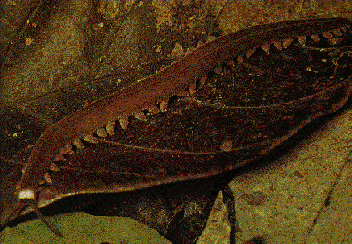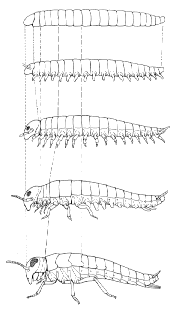
 What Did the Insects Come From?
What Did the Insects Come From?

The most primitive-looking of the insects alive today, such wingless species as the silverfish, have lead biologists to believe that insects may have evolved from a creature similar to the Annelida. This supposed ancestor had a segmented, worm-like body with a pair of feet on each segment and may have looked something like the creature in the photo above (a member of the phylum Onychophora, this creature has a worm-like body with a head and antennae and one pair of stubby, telescoping legs on each segment). One hypothesis shows the first five segments of such an animal coalescing to form the head, the next three the thorax, and the remainder being left for the abdomen, as in the diagram below. The concentration of locomotive mechanisms in the thorax would have relieved the hind sections of the need for leg muscles and thus allowed them to develop the complex abdominal organs.
 The most commonly accepted theory of the origin of the insects is here illustrated. An organism
resembling the modern earthworm may have grown some kind of legs on each segment as a locomotive aid.
The development of head, thorax, and abdomen by aggregation of segments followed. Various of the limbs
either disappeared or were modified: in the head to become antennae and mouth parts and in the abdomen
they probably just disappeared altogether or became pincers or other structures at the end of the body.
The theory of the merging of segments is supported by the fact that the thorax has six legs (derived
from the pairs on each of three segments), and the head has five ganglia and the thorax
three. Ganglia are nerve bundles, of which there is one in each segment of the annelid worms. The ganglia
serve the purpose of brains in worms and play a lesser role, subordinate to the brain, in insects.
The most commonly accepted theory of the origin of the insects is here illustrated. An organism
resembling the modern earthworm may have grown some kind of legs on each segment as a locomotive aid.
The development of head, thorax, and abdomen by aggregation of segments followed. Various of the limbs
either disappeared or were modified: in the head to become antennae and mouth parts and in the abdomen
they probably just disappeared altogether or became pincers or other structures at the end of the body.
The theory of the merging of segments is supported by the fact that the thorax has six legs (derived
from the pairs on each of three segments), and the head has five ganglia and the thorax
three. Ganglia are nerve bundles, of which there is one in each segment of the annelid worms. The ganglia
serve the purpose of brains in worms and play a lesser role, subordinate to the brain, in insects.
The Eyes
One of the earliest steps in insect evolution was the development of the compound
eye. Every terrestrial animal (except the worm and a few insects) has eyes. The terrestrial
vertebrates all have simple eyes. Many insects also have a few simple eyes, but the
usefulness of these is unclear. If these insects have their compound eyes cover, they behave as though
they were totally blind. With the simple eyes covered, there is little noticeable deviation from normal
behaviour, but some orders (e.g. bees) are known to need them for navigation. It may be that the simple
eyes are only sensitive to the intensity of light and allow it to
discern objects more effectively in such places as forests where there are regions of complex patterns
of light and shade.
The Wings
The next evolutionary 'step' (no pun intended) was the development of wings and deserves a page to itself
later in the tour.

 What Did Insects Come From?...1, March 1996
What Did Insects Come From?...1, March 1996